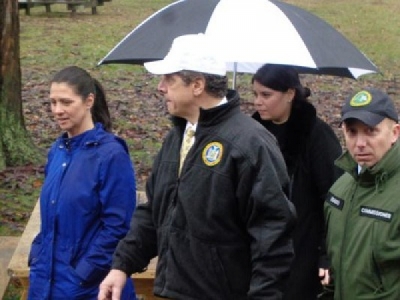
Posted on November 28, 2017
By Richard Moody, HudsonValley360
State Department of Environmental Conservation Commissioner Basil Seggos and other DEC officials have suggested that more testing for PCBs in the lower Hudson River, including spots near Columbia and Greene counties, should be conducted if the federal government has not kept its part of the bargain to clean up the waterway.
The DEC is calling on the U.S. Environmental Protection Agency, and threatening legal action, to reject General Electric’s request to end the project to clean up PCBs from the Hudson River.
Seggos sent a letter Thursday to EPA Director Scott Pruitt imploring him not to end the program requiring GE to clean the upper part of the Hudson, between Fort Edward and the Federal Dam in Troy, for cancer-causing PCBs, which the company dumped in the river.
GE fought the project off for many years after it was discovered the company put 1.3 million pounds of PCBs in the river, but ultimately started dredging the river in 2009 and finished in 2015.
Sean Mahar, a spokesman for the DEC, said Seggos and the DEC had until Nov. 22 to submit comments to the EPA regarding GE’s request.
“The Hudson River is a national historic treasure and we cannot let the PCB contamination persist any longer,” Seggos said. “It’s clear from the state’s ongoing research that EPA’s job is not done and they cannot declare that this remediation is complete. If the federal government fails New York, we will explore all legal options to challenge the EPA’s decision and ensure this river is not left to suffer the consequences of pollution for generations to come.”
Seggos asked the EPA in December 2016, just before the deadline for the EPA’s second five-year review of the cleanup project, requesting that continued testing of the river be conducted by GE and to determine that the dredging was not protective of human life.
The five-year review, released in June, found that the river and fish are recovering as the EPA expected and said the next phase of the cleanup project began, consisting of studying flood plains along the river and monitoring the river’s recovery progress for another five years.
The DEC since has collected more than 1,200 samples from the river and is in the process of validating its results, Mahar said.
The DEC maintains that the cleanup of the river has not gone as well as the EPA suggested in its five-year review.
Seggos letter suggests that remediation tactics prescribed by the EPA were not beneficial to the river environment, concluding, “The EPA must fulfill its obligations under federal and state law to ensure the reconstruction of habitat destroyed through remedial actions on the Hudson River. EPA must identify needed reconstruction and commit to performing it. A certificate of completion for the remedy cannot be issued unless and until all required habitat reconstruction is successful.”
According to the letter, the concentration of PCBs in the target zone are two to three times higher than the EPA anticipated at the beginning of the project.
“Based on all of the existing evidence, it would be wholly inappropriate for EPA to certify this cleanup is complete,” Seggos said. “Until this remedy can be credibly found to be protective of human health and the environment, the EPA must do more to re-evaluate the effectiveness of this remedy and require additional actions to restore the health of this important ecosystem.”
GE responded to the DEC’s letter by saying it completed what it was required to do and under the law they should be relinquished from duty.
“GE successfully completed the Hudson River dredging project in 2015, having invested $1.7 billion, having removed all of the PCBs that EPA targeted for removal and having met all of our commitments to the EPA and New York state,” said Mark Behan, a spokesman for GE. “The state played an instrumental role in every major decision related to the dredging project and approved and oversaw the work. Nothing in DEC’s statement disputes that GE met all of its obligation.”
Linda Dunn, of Palenville, said she is not sure if GE should remain on the hook, saying it depends on how much of the river is clean of PCBs.
“It depends on to what degree the river is clean. If it is 80 percent clean, maybe, but if it is only 20 percent clean no way,” Dunn said. “If you put the PCBs in the river, you should take responsibility and clean it up.”
The project targeted only a section of the upper Hudson River, but Seggos and the DEC have suggested that more testing of water in the lower Hudson, including spots near Columbia and Greene counties should be tested further and possibly remediated.
“I think they should keep dredging,” said Barry Babjeck, of Hillsdale. “Clean up the mess they made of the river.”
The EPA released a statement that it would consider Seggos’ letter in its decision, which the agency expects to make by the end of the year.
“Under the judicial Consent Decree entered in 2006, the EPA has an obligation to respond to General Electric’s request for a Certificate of Completion within 12 months of receiving that request and appropriate supporting documentation,” according to the agency’s statement. “The Certificate of Completion, if and when issued, certifies that the company properly performed the activities required of it under the 2006 Judicial Consent Decree with respect to the dredging and related work.”
Source: HudsonValley360





